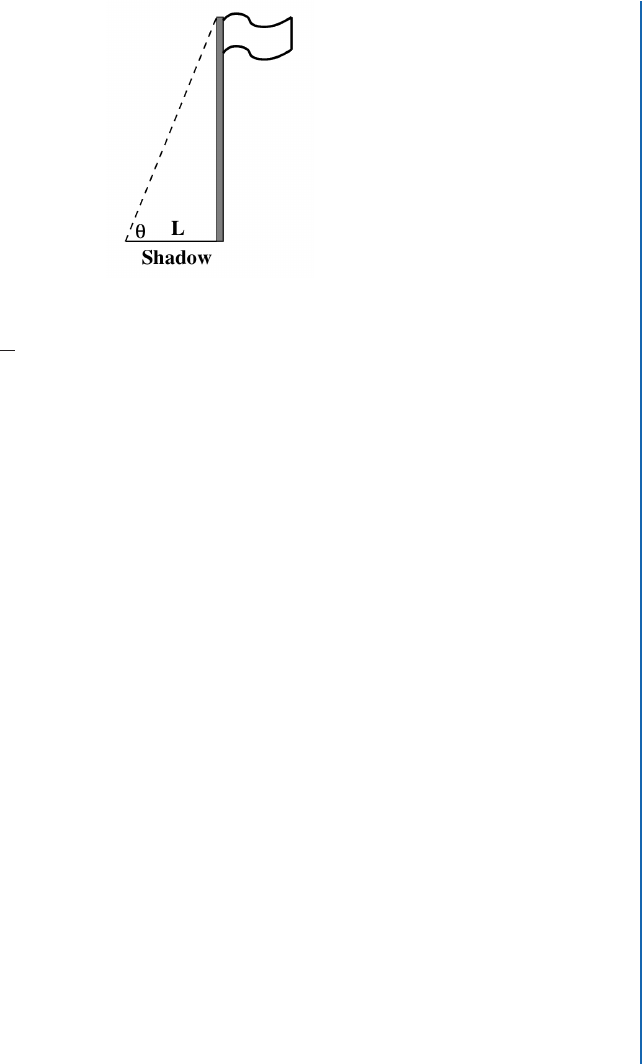
2.3. TRIGONOMETRIC FUNCTIONS 69
2.3.4 EULER’S IDENTITY
is section contains a computational trick for quickly recovering the various sum-of-angles,
difference-of-angles, and the double angle identities. is section is an enrichment section; it
contains a small amount of something we normally would not cover in a first-year calculus course.
Definition 2.8 i D
p
1.
e problem with the above definition is that it defines something you have been told does not
exist—probably ever since you first encountered square roots. In English, i is the square root of
negative one. e way you deal with this is that i is a number, albeit a funny one, with the added
property that i
2
D 1. For the time being accept it as a notational shortcut. Once we have i
available, one of the great truths of the universe, Euler’s Identity, becomes possible to state.
Knowledge Box 2.25
Euler’s Identity
e
i
D i sin./ C cos./
In order to make use of Euler’s identity we need to know a little bit about complex numbers.
Definition 2.9 A complex number is a number of the form a C bi where a and b are real numbers.
We say that a is the real part of the complex number and b is the imaginary part. If a D 0 the number
is an imaginary number. If b D 0, the number is a plain real number.
Here are the four basic arithmetic operations for complex numbers.
1. .a C bi / C .c C di/ D .a C c/ C .b C d /i
2. .a C bi / .c C di/ D .a c/ C .b d /i
3. .a C bi / .c C di/ D .ac bd/ C .ad C bc/i
4.
.a C bi/
.c C di/
D
ac C bd
c
2
C d
2
C
bc ad
c
2
C d
2
i
One last fact is needed before we can reap the benefits of Euler’s identity. If a C bi D c C di,
then a D c and b D d: In English, if two complex numbers are equal, then their real parts and
their imaginary parts are also equal. On to harvest results!
Example 2.52 In this example we derive the two double angle identities as the real and
imaginary parts of a single expression:

70 2. THE LIBRARY OF FUNCTIONS
e
2i
D
e
iCi
D
e
i
e
i
i sin.2/ C cos.2 / D .i sin./ C cos.// .i sin./ C cos.//
D cos
2
./ sin
2
./ C i
.
2 sin./ cos./
/
Pulling out the real and imaginary parts we obtain the two double angle identities:
cos.2/ D cos
2
./ sin
2
./ (real)
sin.2/ D 2 sin./ cos./ (imaginary)
˙
All the sum and difference of angle identities can be derived in a similar fashion, something we
leave for the homework.
PROBLEMS
Problem 2.53 Remembering that sine and cosine are periodic with period 2, find the exact
values for the following, expressed with radicals rather than decimal numbers.
1. cos.5=3/
2. sin.7=6/
3. tan.=3/
4. sec.3=4/
5. cos.11=4/
6. cot.27=4/
7. sin.131=4/
8. sin.11=6/
Problem 2.54 Find the set of all angles, in radians, that have a cosine of
p
2
2
.

2.3. TRIGONOMETRIC FUNCTIONS 71
Problem 2.55 Find the domains of the following functions.
1. f .x/ D sin
1
x
2. g.x/ D cot.x/
3. h.x/ D cos
p
x
4. r.x/ D sec.cos.x//
5. s.x/ D csc.sin.x//
6. q.x/ D
p
cos.x/
Problem 2.56 Find the ranges of the following functions.
1. f .x/ D tan
cos.x/
2
2. g.x/ D cos
x
2
3. h.x/ D csc
x
2
4. r.x/ D sin
x
2
C 1
5. s.x/ D tan
x
2
C 1
6. q.x/ D cos
1
x
Problem 2.57 Give exact formulas, using radicals rather than decimals, for each of the follow-
ing trig functions. Simplify your expressions as much as you can. Hint: the sum and difference
of angle formulas may help.
1. cos
12
2. sin
7
12
3. cos
5
12
4. tan
5
12
5. cot
12
6. sec
7
12
Problem 2.58 Using the diagram from Figure 2.9: if ˛ D
3
, A D 5, and B D 4, what are C ,
ˇ, and ?
Problem 2.59 Using the diagram from Figure 2.9: if ˛ D
3
, ˇ D
4
, and A D 4, what are B,
C , and ?

72 2. THE LIBRARY OF FUNCTIONS
Problem 2.60 Using the diagram from Figure 2.9: if ˛ D
5
, ˇ D
5
, and A D 2, what are B,
C , and ?
Problem 2.61 Show that the following are true, based on material given in this section.
1. sin./ D
p
1 cos
2
./
2. cos./ D
p
1 sin
2
./
3. tan. C / D
tan./ C tan./
1 tan./ tan. /
4. tan. / D
tan./ tan./
1
C
tan
./
tan
./
5. tan.2/ D
2 tan./
1 tan
2
./
6. tan
2
./ D
1 cos.2/
1 C cos.2/
Problem 2.62 What happens to the law of cosines when the angle is a right angle? Refer to
the definition of the law of cosines in the text.
Problem 2.63 Prove that a right isosceles triangle has, in addition to its right angle, two angles
that are
4
radians. Also show that the ratio of the side lengths of this triangle is 1 W 1 W
p
2.
Problem 2.64 Prove that a right triangle with one of its other angles of size
6
also has an
angle of size
3
. Also show that the ratio of the side lengths of this triangle is 1 W
p
3 W 2.
Problem 2.65 Suppose that the repeated angle of an isosceles triangle has the value D
6
,
and that its longest side has length 2. Find the other angle and the lengths of the other sides.

2.3. TRIGONOMETRIC FUNCTIONS 73
Problem 2.66 Refer to the diagram of the flag pole. If the shadow length is L D 16m and the
angle measures as D
4
rad , then how tall is the flagpole?
Problem 2.67 Refer to the diagram of the flag pole. If the shadow length is L D 6m and the
angle measures as D 1:1 rad, then how tall is the flagpole?
Problem 2.68 Refer to the diagram of the flag pole. If the shadow length is L D 4m and the
angle measures as D 1:4 rad, then how tall is the flagpole?
Problem 2.69 Explain for which right triangle cos
2
./ C sin
2
./ D 1 is an instance of the
Pythagorean theorem.
Problem 2.70 Use Euler’s identity to derive the sum-of-angles identities.
Problem 2.71 Use Euler’s identity to derive the difference-of-angles identities.
Problem 2.72 Use Euler’s identity to derive the double angle identities.
Problem 2.73 Use Euler’s identity to derive the half angle identities.
Problem 2.74 Find an expression in terms of sin. / and cos. / for sin.3 /.
Problem 2.75 Find an expression in terms of sin. / and cos. / for cos.3 /.
..................Content has been hidden....................
You can't read the all page of ebook, please click here login for view all page.
